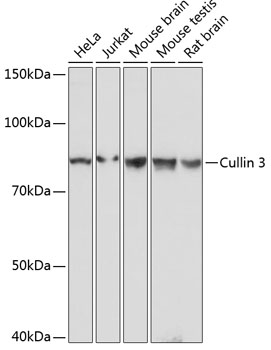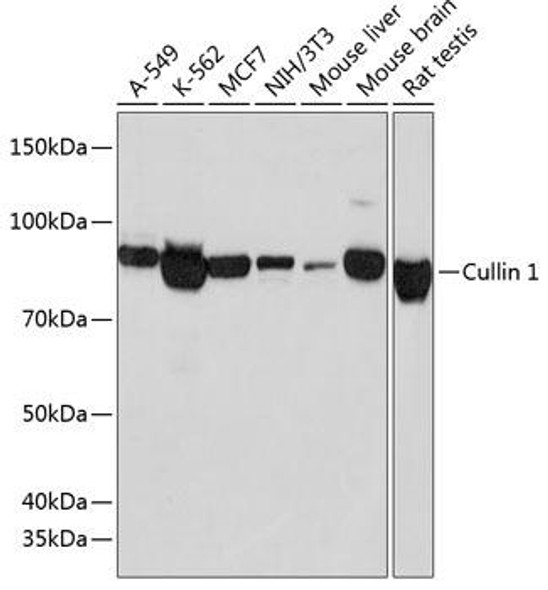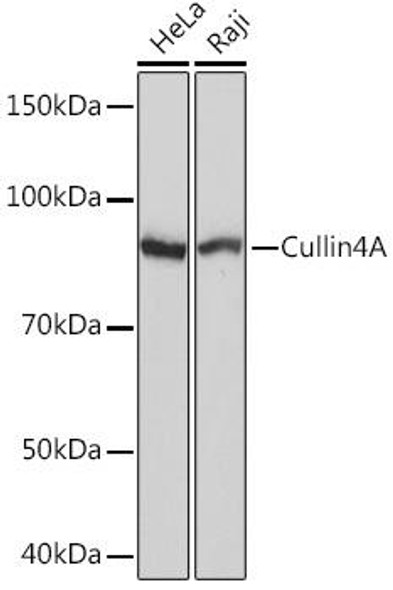Cell Cycle Antibodies 2
Anti-Cullin 3 Antibody (CAB19623)
- SKU:
- CAB19623
- Product Type:
- Antibody
- Reactivity:
- Human
- Reactivity:
- Mouse
- Reactivity:
- Rat
- Host Species:
- Rabbit
- Isotype:
- IgG
- Research Area:
- Cell Cycle
Description
| Antibody Name: | Anti-Cullin 3 Antibody |
| Antibody SKU: | CAB19623 |
| Antibody Size: | 20uL, 50uL, 100uL |
| Application: | WB IHC |
| Reactivity: | Human, Mouse, Rat |
| Host Species: | Rabbit |
| Immunogen: | A synthesized peptide derived from human Cullin 3. |
| Application: | WB IHC |
| Recommended Dilution: | WB 1:500 - 1:2000 IHC 1:50 - 1:200 |
| Reactivity: | Human, Mouse, Rat |
| Positive Samples: | HeLa, Jurkat, Mouse brain, Mouse testis, Rat brain |
| Immunogen: | A synthesized peptide derived from human Cullin 3. |
| Purification Method: | Affinity purification |
| Storage Buffer: | Store at -20°C. Avoid freeze / thaw cycles. Buffer: PBS with 0.02% sodium azide, 0.05% BSA, 50% glycerol, pH7.3. |
| Isotype: | IgG |
| Sequence: | Email for sequence |
| Gene ID: | 8452 |
| Uniprot: | Q13618 |
| Cellular Location: | |
| Calculated MW: | 89kDa |
| Observed MW: | 89KDa |
| Synonyms: | CUL-3, PHA2E, CUL3, Cullin 3, cullin-3 |
| Background: | This gene encodes a member of the cullin protein family. The encoded protein plays a critical role in the polyubiquitination and subsequent degradation of specific protein substrates as the core component and scaffold protein of an E3 ubiquitin ligase complex. Complexes including the encoded protein may also play a role in late endosome maturation. Mutations in this gene are a cause of type 2E pseudohypoaldosteronism. Alternatively spliced transcript variants encoding multiple isoforms have been observed for this gene. [provided by RefSeq, Mar 2012] |
| UniProt Protein Function: | CUL3: a core component of multiple cullin-RING-based BCR (BTB- CUL3-RBX1) E3 ubiquitin-protein ligase complexes which mediate the ubiquitination and subsequent proteasomal degradation of target proteins. As a scaffold protein may contribute to catalysis through positioning of the substrate and the ubiquitin-conjugating enzyme. The E3 ubiquitin-protein ligase activity of the complex is dependent on the neddylation of the cullin subunit and is inhibited by the association of the deneddylated cullin subunit with CAND1. The functional specificity of the BCR complex depends on the BTB domain-containing protein as the susbstrate recognition component. SPOP is involved in ubiquitination of BMI1, H2AFY and DAXX, and probably GLI2 or GLI3. BCR(KLHL9-KLHL13) controls the dynamic behavior of AURKB on mitotic chromosomes and thereby coordinates faithful mitotic progression and completion of cytokinesis. BCR(KLHL12) is involved in ER-Golgi transport by regulating the size of COPII coats, thereby playing a key role in collagen export, which is required for embryonic stem (ES) cells division: BCR(KLHL12) acts by mediating monoubiquitination of SEC31A or -B. BCR(KLHL3) acts as a regulator of ion transport in the distal nephron; possibly by mediating ubiquitination of SLC12A3/NCC. Involved in ubiquitination of cyclin E and of cyclin D1 (in vitro) thus involved in regulation of G1/S transition. Forms neddylation-dependent homodimers. Component of multiple BCR (BTB-CUL3-RBX1) E3 ubiquitin-protein ligase complexes formed of CUL3, RBX1 and a variable BTB domain-containing protein acting as both, adapter to cullin and substrate recognition subunit. The BCR complex may be active as a heterodimeric complex, in which NEDD8, covalently attached to one CUL3 molecule, binds to the C-terminus of a second CUL3 molecule. Interacts with RBX1, RNF7, CYCE and CAND1. Part of the BCR(SPOP) containing SPOP. Part of the probable BCR(KLHL9-KLHL13) complex with BTB domain proteins KLHL9 and KLHL13. Part of the BCR(KBTBD10) complex containing KBTBD10. Component of the BCR(KLHL12) E3 ubiquitin ligase complex, at least composed of CUL3 and KLHL12 and RBX1. Component of the BCR(KLHL3) E3 ubiquitin ligase complex, at least composed of CUL3 and KLHL3 and RBX1 (Probable). Part of the BCR(ENC1) complex containing ENC1. Part of a complex consisting of BMI1, CUL3 and SPOP. Part of a complex consisting of H2AFY, CUL3 and SPOP. Interacts with KCTD5, KLHL9, KLHL13, GAN, ZBTB16, KLHL21, KLHL3, KLHL15, KLHL20, C16orf44, GMCL1P1, BTBD1. Part of a complex that contains CUL3, RBX1 and GAN. Interacts (via BTB domain) with KLHL17; the interaction regulates surface GRIK2 expression. Widely expressed. Belongs to the cullin family. 3 isoforms of the human protein are produced by alternative splicing. |
| UniProt Protein Details: | Protein type:Cell cycle regulation; Ubiquitin ligase; Ubiquitin conjugating system Chromosomal Location of Human Ortholog: 2q36.2 Cellular Component: Golgi membrane; nucleoplasm; membrane; polar microtubule; cytosol Molecular Function:protein binding; cyclin binding; protein homodimerization activity; protein heterodimerization activity; ubiquitin protein ligase binding; ubiquitin-protein ligase activity; POZ domain binding Biological Process: protein monoubiquitination; positive regulation of cytokinesis; integrin-mediated signaling pathway; proteasomal ubiquitin-dependent protein catabolic process; ER to Golgi vesicle-mediated transport; cell migration; Wnt receptor signaling pathway; protein polyubiquitination; stem cell division; protein ubiquitination; gastrulation; mitotic metaphase plate congression; embryonic cleavage; cyclin catabolic process; COPII coating of Golgi vesicle; negative regulation of Rho protein signal transduction; positive regulation of cell proliferation; stress fiber formation; positive regulation of mitotic metaphase/anaphase transition; trophectodermal cellular morphogenesis; cell cycle arrest; G1/S transition of mitotic cell cycle Disease: Pseudohypoaldosteronism, Type Iie |
| NCBI Summary: | This gene encodes a member of the cullin protein family. The encoded protein plays a critical role in the polyubiquitination and subsequent degradation of specific protein substrates as the core component and scaffold protein of an E3 ubiquitin ligase complex. Complexes including the encoded protein may also play a role in late endosome maturation. Mutations in this gene are a cause of type 2E pseudohypoaldosteronism. Alternatively spliced transcript variants encoding multiple isoforms have been observed for this gene. [provided by RefSeq, Mar 2012] |
| UniProt Code: | Q13618 |
| NCBI GenInfo Identifier: | 12643396 |
| NCBI Gene ID: | 8452 |
| NCBI Accession: | Q13618.2 |
| UniProt Secondary Accession: | Q13618,Q9JLV5, |
| UniProt Related Accession: | Q13618 |
| Molecular Weight: | |
| NCBI Full Name: | Cullin-3 |
| NCBI Synonym Full Names: | cullin 3 |
| NCBI Official Symbol: | CUL3 |
| NCBI Official Synonym Symbols: | CUL-3; PHA2E |
| NCBI Protein Information: | cullin-3 |
| UniProt Protein Name: | Cullin-3 |
| Protein Family: | Cullin |
| UniProt Gene Name: | CUL3 |
| UniProt Entry Name: | CUL3_HUMAN |







